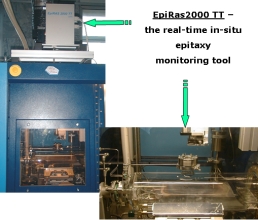MOCVD installations
MOCVD installations
Homemade MOCVD reactor
Since 1994 the researches in the field of high efficiency single junction solar cells based on the AlGaAs/GaAs have been carried out on a homemade low pressure MOCVD reactor (Figure 1). The MOCVD installation was equipped with four MO lines and two hydride lines.

Figure 1. Homemade low pressure MOCVD reactor.
The structures GaAs/Ge, single junction GaAs solar cells with and without internal Bragg reflectors, QW and QD lasers were grown in this reactor. The efficiency of 23.8% (AM0, 100 suns) was achieved on the radiation resistant GaAs solar cells with Bragg reflector and 22.5% (AM0, 70 suns) on the GaAs solar cells without Bragg reflector. The outdoor efficiency 27.5% (AM1.5D, 90 mW/cm2) has been received at 140 suns as well.
GaAs/Ge photo converters with high photocurrent and open circuit voltage have been obtained by combination of atmospheric MOCVD with Zn diffusion. These cells showed high efficiency of 4.3% at 400 suns (AM1.5D) behind GaAs cell with wafer thickness about 450 mm. Investigations of different TPV cell structures based on Ge were performed and efficiency of 12% was observed in Ge cells with a passivating wideband GaAs window.
AIXTRON AIX 200/4 reactor
The activity in the field of creating structures of tandem multijunction solar cells started in 2004 when the new AIXTRON AIX 200/4 system was installed in the laboratory (Figure 2).
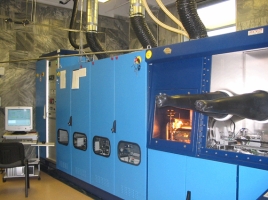
Figure 2. AIXTRON AIX 200/4 MOCVD installation.
This reactor was developed for R&D and low scale production. The following configurations are available in AIX 200/4 reactor:
- 1 x 4" wafer per run, total area = 325 cm2
- 3 x 2" wafer per run, total area = 60 cm2
- 1 x 3" wafer per run, total area = 182 cm2
- 1 x 2" wafer per run, total area = 20 cm2
Installation AIX 200/4 is based on horizontal low pressure reactor with gas rotation of the wafers (Figure3). Hydrogen and nitrogen can be used as carrier gas. The growth pressure in reactor chamber can be at the range 50 - 1000 mbar, growth temperature (controlled by IR heater) can be kept at range 400 - 800oC.

Figure 4. AIX 200/4 reactor in case of 3x2'' wafer per run configuration.
Separated feeds for MO's and hydrides in combination with the rapid gas velocities minimize parasitic reactions and result in very efficient use of precursors and higher uniformity of growth rate and composition. Good uniformity for all possible configurations can be obtained by change of total flow and MO/Hydride flows ratio. The best uniformity of growth rate (<1% Std. Dev, Figure 4) and composition was reached in the 1x2'' configuration
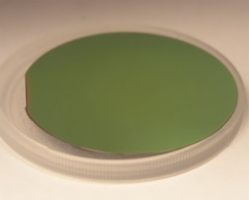
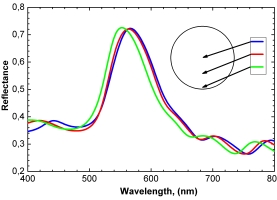
Figure 4. AlAs/GaAs Bragg reflector with less 1% Std. Dev, grown in the 1x2'' configuration and reflectance spectra from 3 points of wafer.
Eight MO lines and four hydride lines are included in our AIXTRON system. Al-Ga-In-P, Al-Ga-As and Al-Ga-In-As materials are available to be grown with different n- and p-doping atoms. This configuration makes possible to grow different modern multijunction solar cells structures.
There are two Epison 4 sensors (Figure 5), which measures and controls the MO molecules concentration, installed in the lines, where solid MO is used. This tool makes possible to exclude influence of non-constant vapor pressure above solid TMIn on incorporation of the indium atoms in grown layers and also compatible with other MO.
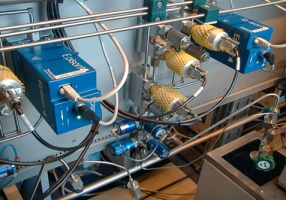
Figure 4. Two Epison 4 sensors.
In the 2005 AIXTRON MOCVD system was upgraded with EpyRAS 2000TT (Figure 6) in-situ monitoring system. This tool consists of three parallel measurements: normalized reflection, reflectance anisotropy (RAS) and emissive correct pyrometry (TT), which makes possible to measure growth rates, compositions, doping levels, surface stoichiomerty, interface properties and real wafer temperature during growth.
Using of EpiRAS 2000TT allows measuring the following parameters of the grown materials:
- refractive (n) and absorption (k) indexes for any material;
- growth rates for many materials can be obtained with accuracy about 1-3%;
- composition mainly for ternary alloys with accuracy of 1-2%;
- doping levels can be calibrated for all materials with n ~ 1016-1018 or p ~ 1017-1019
The using of the EpiRAS also makes possible to control processes of the deoxidation of wafer which especially necessary in the case of growth on Ge wafers. The permanent monitoring of the value of reflection signal gives information about growth surface conditions and quality.
The first dual-junction (DJ) solar cells in Russia were created on this equipment. The high efficiencies of 30.03% at 40 suns (AM1.5D) and 26.5% at 30 suns (AM0) were obtained on GaInP/GaAs DJ solar cells grown on AIX 200/4 reactor.
